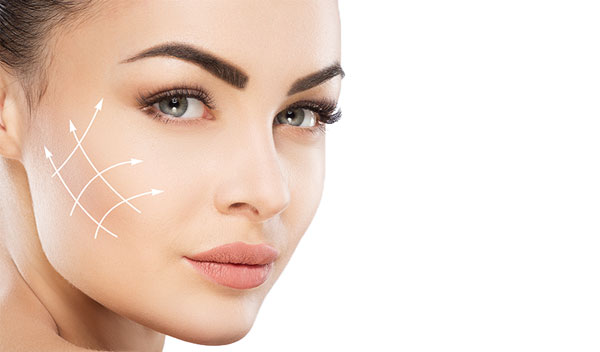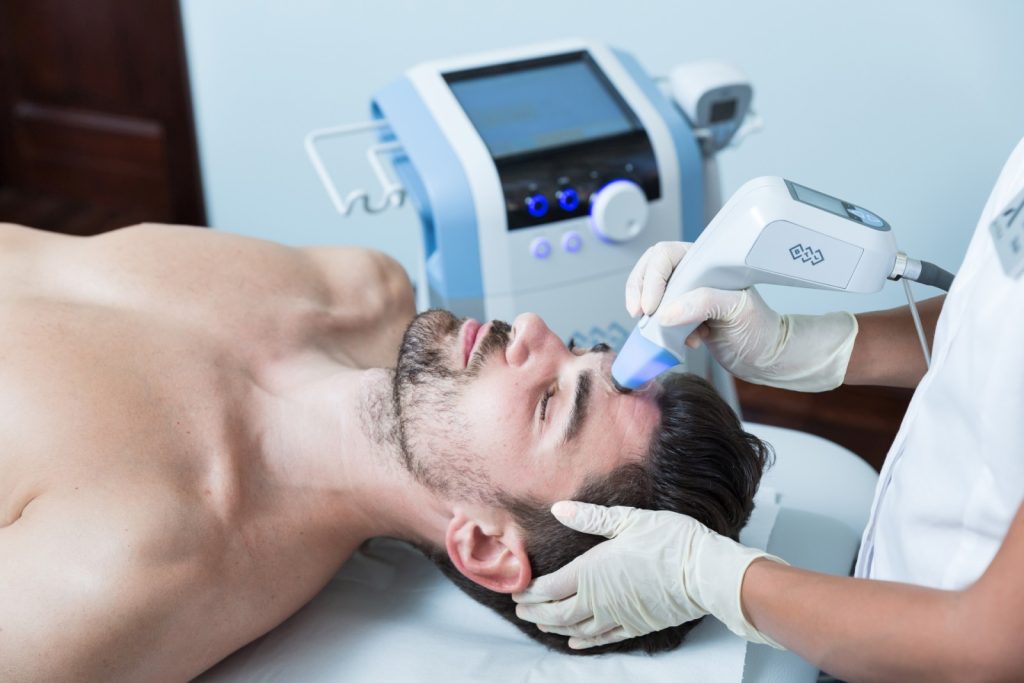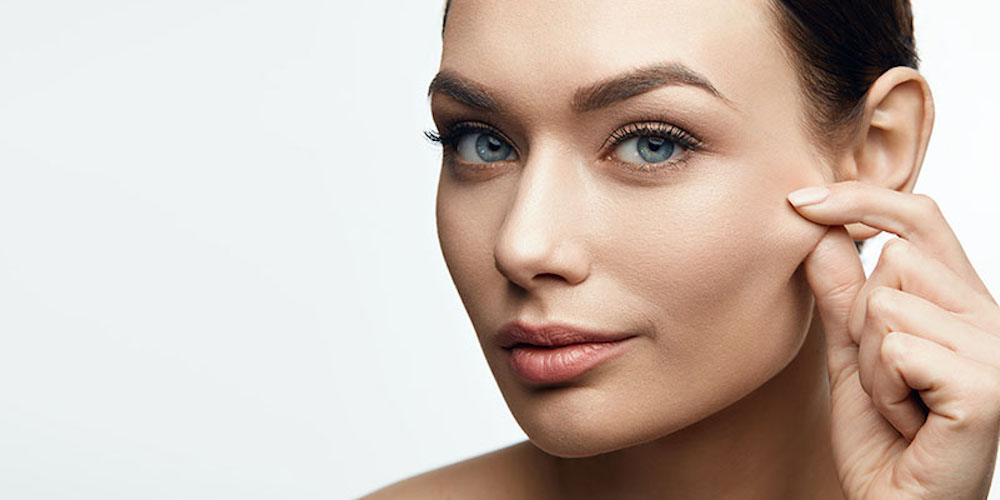Just when you got your head around Morpheus 8 and radiofrequency treatments , along comes another skin-transforming, energy-based facial technology that has doctors and their clients hopping with excitement.
Ultrasound facials aren’t new, but they are getting increasingly sophisticated and effective (and less agonisingly painful). Brand-new machines such as HIFU and Focus Dual are becoming the last word in lifting, tightening skin tech, with cosmetic physician Dr Sophie Shotter saying of the former: “Having a comfortable technology that can not only lift the face, but the delicate eye area as well, is an industry first.”
With our focus shifting from our foreheads and lips to our jawlines thanks to that infernal, Covid-induced ‘Zoom boom’, it’s no surprise the hunt has been on for tweakments to tackle the hardest-to-improve skin issue: facial sagging and jowls. And it seems that Jennifer Aniston and Kim K. may have been onto something with their early uptake of ultrasound facials for skin-tightening. To decide whether you want to follow in their age-defying wake, read on.
What is an ultrasound facial?
The ultrasound facial treatments performed in clinics by doctors and advanced skincare practitioners are mostly HIFU, or High Intensity Focused Ultrasound, procedures. They employ a treatment head that emits intense ultrasound waves whose energy is focused to a single point below the skin surface (this is very different from the non-focused energy employed in ultrasound imaging, used to monitor unborn babies). There, without damaging the surface, it creates tiny dots of micro-injuries at a pre-determined depth. These injuries will set off a healing response that induces the production of collagen and elastin cells, crucial to the firmness and elasticity of your skin.
HIFU machines mainly focus their energy 4.5mm below the skin surface, hitting a layer of muscular tissue called the SMAS. This is the same layer surgeons manipulate when they do a facelift, and injuring it with ultrasound energy will have a somewhat similar result. The layer will thicken and tighten, pulling the skin tissue above it taut and resulting in a more streamlined, lifted look. Most of these machines can also target the upper and lower dermis, the area where collagen is generated within in the skin itself, for an additional tautening effect.
What can ultrasound do for your skin?
Ultrasound facials can tone and tighten skin, and when used to target the dermis can also help plump out lines, wrinkles and crepiness. They have been known to ‘slim’ the face as well – something that can happen when the energy hits the fat layer situated just above the SMAS layer and right underneath the dermis, destroying the fat cells and causing ‘shrinkage’. Although some people consider this a happy side effect, it isn’t necessarily meant to happen and can cause issues – more about that later.
Image: HIFU Courtesy of Arielle Kauvar, MD
At what age should you consider ultrasound facials?
The ’lift’ you get from an ultrasound facial can be very visible, but that doesn’t mean it’s a facelift alternative. “It’s good for skins that are somewhat, but not severely, loose,” is how tweakments doyenne Alice Hart-Davis puts it, saying that it’ll take the assessment of a reputable doctor to determine what’s right for you. Davis believes that younger people (say, those in their ‘40’s), may get more dramatic results, because at this age your body will make a lot more collagen in response to being injured than skins in their ‘60’s will. However, therapists at Shotter’s clinics have observed that the most dramatic results from the new HIFU ultrasound treatment are being seen in women in their ‘50’s with relatively mild signs of sagging.
Some people advocate ‘collagen banking’ with ultrasound: because natural collagen production is so high in your 20’s and 30’s, the idea is that this treatment will ‘lay down’ a store of extra collagen to maintain plumpness as the body’s production slows down with age. There is no proof that the skin works this way though, so you may be wasting your money – although if you do have premature laxity in say, your ‘30’s, the results will likely be good.
Are ultrasound facials better than Botox and fillers?
These treatments work in entirely different ways. Botox gets rid of lines and wrinkles and can give the brow a ‘lifted’ look in places (although it can also make brows sag, depending on your anatomy). Fillers are often used under the muscle to elevate the tissues and cause a lifted look, which is why they are considered a good option for a subtle lift in skinny and gaunt faces. Ultrasound has long been top choice for lifting and tightening full and round faces, especially considering the possibility of fat loss.
But with the right machine and therapist, fat loss can be avoided while the lifting/tautening effect can be pronounced and long-lasting. So for jawline and jowl streamlining, ultrasound facials are potentially the best option this side of plastic surgery. Skin therapist Debbie Thomas , who has been using the new Focus Dual ultrasound machine on herself, credits it for allowing her to turn to fillers and Botox far less often, as the technology, she says, keeps her face looking firm and youthful.
Image: HIFU
What is the difference between Ultherapy, ULTRAcel and HIFU?
HIFU is the acronym and ‘name’ for this type of treatment, e.g. lifting and tightening ultrasound technology. Ultherapy and ULTRAcel are brand names for two of the most popular and best-regarded HIFU machines. We’ll discuss these here, alongside a brand-new device making (sound)waves among experts, called the Focus Dual.
Ultherapy
This is the trademarked name for the HIFU treatment performed by a device called Ulthera; both words basically mean the same thing. Ultherapy is the only HIFU device cleared by the American FDA (who assess clinical safety and efficacy) for lifting the skin on the neck, brow and area under the chin (jowls), as well as for improving a crepey chest. The big point of difference of the Ulthera system is that it incorporates an ultrasonic visualisation unit that lets the therapist see all the layers inside the skin, allowing her or him to target the energy beam precisely. This is important because it allows them to avoid the fat layer, which in most cases you do not want to be destroyed. It’s not 100% fool-proof though; by all accounts, the skill of the practitioner is a very important factor for success as well.
ULTRAcel
The Ultracel machine has no visualisation unit – the brand says the depths are very precisely calibrated, although it must be said that people’s skins come in various thicknesses, which could affect where the ultrasound energy hits. Its great selling point is that it has HIFU as well radiofrequency modalities. Radiofrequency energy creates pulses of intense heat to cause those all-important ‘micro injuries’, this time in the upper layers of the skin. Ultracel offers two ways of delivering this energy: fractional radiofrequency/Thermage and radiofrequency microneedling. You can choose your modality or have them applied one after another, but together, they tackle the superficial, medium and deepest skin layer, aiming to improve laxity as well as skin texture.
Focus Dual
Image: Focus
This newly launched device combines HIFU and radiofrequency microneedling like Ultracel, but the breakthrough here, says Thomas, is a different kind of energy beam that near-eliminates the risk of heating up areas you don’t want to affect, like the fat cell layer. On top of that, the company says their microneedles are much finer than average, minimising pinpoint bleeding and bruising while effectively improving skin texture, with less-visible lines, pores, and scars as a result. It even, says Thomas, helps with acne, as the radiofrequency (or RF) heat kills bacteria.
What is HIFU?
Image: HIFU
HIFU is another brand-new ultrasound machine creating a lot of headlines, but it’s not a HIFU device. “HIFU is an entirely different technology,” says Dr Shotter. “It uses ultrasound energy, but that’s where the similarities end. Rather than creating one focused thermal hotspot, it uses parallel cylinders of heat within the skin at a depth of 1.5mm, where the skin produces collagen and elastin.” This, she says, effectively does away with the risk of fat contraction, but is very successful at tightening and firming the skin (though not the muscle layer) as well as minimising lines and wrinkles. So successful, in fact, that HIFU has been awarded clearance by the FDA for skin tightening and lifting and improving facial lines and wrinkles.
HIFU avoids the SMAS and that is just fine for Dr Shotter, who doesn’t want to go near it for a particular reason: “It can induce quite significant fibrosis [permanent tissue hardening] in the SMAS, and if the patient has a subsequent facelift the plastic surgeon will hate us, as it will make their job so much harder,” she says.
Another benefit of HIFU is that it can be used very close to the eye; HIFU can only get as close as just outside the orbital bone. Some doctors, including oculoplastic surgeon Dr Sabrina Shah-Desai , offer the option of having the treatment just as a brow lift, with some very pleasing potential results.
Can ultrasound facials melt fat in the face?
Yes. HIFU practitioners routinely maintain that the risks are very low (which in the scheme of things, they are), but Hart-Davis, who advises consumers on the best tweakments for their issues, says that over the past decade, hundreds of clients have reported this problem with HIFU. We even know of a beauty editor colleague who has experienced it, saying unintended fat contraction left her face looking laxer instead of firmer.
As said, your result is highly dependent on the practitioner’s skill and the quality of the machine used – a careful choice should indeed make the risk quite small. But it’s also worth remembering that many people like HIFU precisely because it can make full faces look slimmer, and that it’s even used on the body (admittedly in a targeted setting) for ‘melting fat’. So the risk is there.
Even if you like the idea of some fat loss, you may want to avoid the possibility. “I’ve always been concerned about HIFU-induced fat loss for my patients,” says Dr Shotter. “If they decided to graduate to a facelift, destroying fat in the face (on top of the risk of fibrosis) is not conducive to having a good result.”
Can you have ultrasound treatments on the body?
Yes. There are dedicated HIFU machines that target fat cells in the abdomen, thighs and other areas, aiming to destroy them permanently and thereby doing exactly the thing most try to avoid for their face. We’ve tried these in the past with little success (and a lot of pain), but we also know Dr Anita Sturnham uses an ultrasound and RF device called Exilis Elite and rates the results the gets when treating her own tummy. HIFU machines are also used on places like the chest to tackle crepiness, and knees to smooth sagging. And Thomas uses her Focus Dual -although in the radiofrequency microneedling modality- to minimise stretch marks.
Can I have ultrasound facials while pregnant?
Energy-based treatments like HIFU, radiofrequency, HIFU and laser are not recommended during pregnancy, simply because we don’t have enough information regarding their effects on the foetus.
Are ultrasound facials suitable for skins of colour?
Because HIFU, HIFU, and RF microneedling bypass the epidermis where melanocytes reside and don’t wound the upper skin layer, none of these treatments should cause post-inflammatory hyperpigmentation and are safe for skins of colour.
Do ultrasound facials hurt?
We say they definitely do, despite some people (somehow, these always tend to be therapists and ultrasound company representatives) saying they’re merely a bit uncomfortable. Hart-Davis knows of people jumping off the treatment bed in agony, but for most it’s a case of bracing hard for the stabs of hot heat that abate just as you think it’s going to be too much. Targeting the SMAS is particularly painful as it hits a deep muscle layer, and bony areas such as the brow are also torturous. We wouldn’t do it without numbing cream, although this won’t take all the pain away either.
Focus Dual and HIFU are said to be less painful than Ultherapy and other HIFU treatments, with HIFU in particular being marketed as ‘almost painless’. We’ll call that a non-truth; we’ve tried it. With very strong anaesthetic cream and some clever tricks from an experienced practitioner, it was perfectly doable but we were still at times gritting our teeth hard. So don’t be fooled and prepare for the worst, then it might not be as bad as you think.
What are the downtime and side effects of ultrasound like?
Ultrasound treatments generally have no downtime; you can’t see traces on the face apart from some potential redness which is often in fact caused by the numbing cream. HIFU can cause mild swelling and tenderness for a number of weeks, and/or a tingling sensation and a sort of ‘muscle ache’ in the jaw. In rare cases, bruises, large welts and scratch-like marks happen, as well a localised numbness which can last two weeks, and there is the small risk of fat loss.
Additional radiofrequency microneedling will leave you very red for a few hours and can cause pinpoint bleeding, as well as bruises on rare occasions
How long does an ultrasound facial take?
HIFU can take 30-90 minutes depending on the area (from just the brow to the full face and neck), while HIFU takes 30-45 minutes. But add a good half hour to wait for the anaesthetic cream to kick in.
How long does the result of an ultrasound facial last?
Because it takes at least three months for the body to build new collagen, don’t expect a speedy transformation. Full results from HIFU are seen at six months (or even nine), which is why you can’t have these treatments more often than every six months (aside from the series of initial sessions some brands require). Results from HIFU can last a good year to 18 months (radiofrequency microneedling may be had every 2-3 months, if you really wanted to).
Full results from HIFU, which generates collagen in more superficial skin layers, may be seen at three months (though up to six months is possible) and can last for a year.
Image: HIFU Courtesy of Dr. Jason Bloom
As for the number of treatments you need for full results: Ultherapy requires just one treatment, while Ultracel recommends an initial two treatments in four months for HIFU. Focus Dual HIFU requires 2-3 initial treatments space 3-4 weeks apart. HIFU recommends one treatment (but two within six months if laxity is relatively severe) for maximum results.
Are ultrasound facials expensive?
They are. Ultherapy for the full face and neck can easily set you back £4500, especially in London. Ultracel for the full face and neck can cost £1500-£2000 for two sessions. Expect to pay £1600 for one Focus Dual full face and neck treatment in London. HIFU is roughly £3000 for the full face and neck in London. Prices outside of the capital will almost always be lower.
So ultrasound facials are definitely an investment, but they’re quick and virtually downtime-free, with results that can build up over time and leave your skin looking healthier and youthful for longer. And as the technology improves, they may even become genuinely ‘comfortable’ to have one day.








